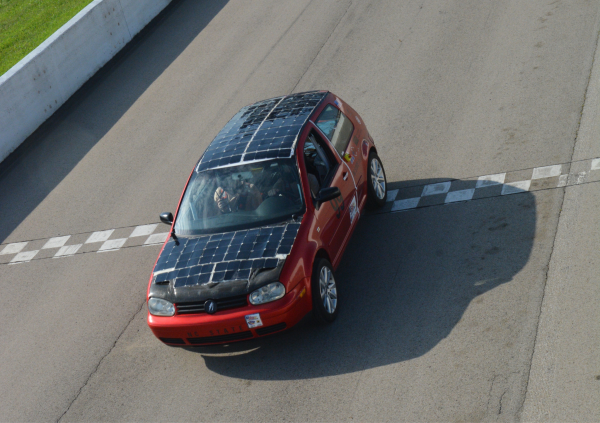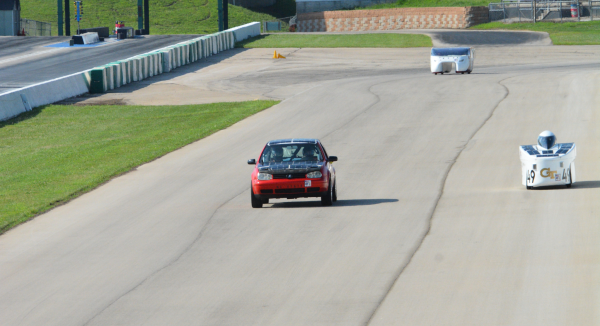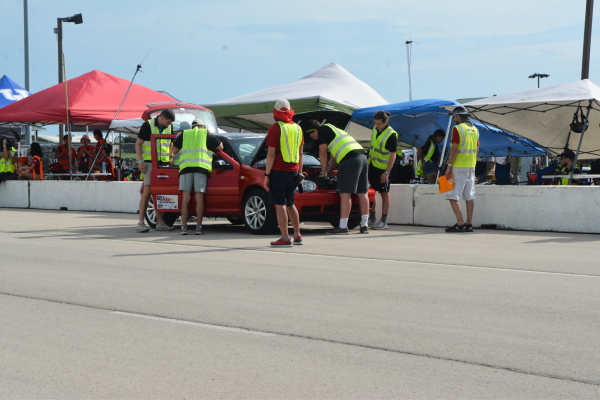The NC State University solar car team, SolarPack, completed the fastest lap in the 30+ year history of the Formula Sun Grand Prix (FSGP) competition earlier this month.
Additionally, the team set record, completing the 2.5 mile lap in just over 3 minutes, after spending a mere fraction of the money that other teams spent on their vehicles.
The feat came after SolarPack team traveled to Topeka, Kansas with their converted 2001 VW Golf GTI solar car to compete in the FSGP on July 1, but it was an uphill battle for the team to get to this point.
The competition begins with four days of scrutineering in order to make sure every car meets the standards of the competition. The cars that pass muster during scrutineering then hit the racetrack for three days to see how many laps they can complete in the allotted time. The FSGP also serves as a qualifier for the American Solar Challenge (ASC), in which teams race 1400+ miles along the Oregon National Historic Trail for eight days. To qualify for the ASC, the team’s vehicle must complete 82 laps in a single day or 124 laps in two consecutive days.
This is the second year that SolarPack has been able to race on the Heartland Motorsports Park track after passing scrutineering at the beginning of the competition, after landing on the track for the first time in 2021.
“(Being able to race in 2021) made the event a success and anything that happened after that point was icing on the cake,” SolarPack Technical Director Ben Nichols said Monday.
Last year, the team had a fully developed design for a new car build, Nichols said. Unfortunately, the COVID-19 pandemic became a major roadblock for them, and they were relying on their sponsors to make sure they would make their design a reality, and take it to the FSGP.
“What this meant for us was that we were working with a tight budget to make a $50,000+ build happen,” Nichols said. “We wanted a car that would show the world that solar energy is practical in vehicle application and you can have all of the same things that you have in a modern car in one that is powered off of the sun.”
After many hours of research and browsing craigslist, the team purchased a 2001 VW golf GTI for just $1,000. This cut about $30,000 dollars in car body fabrication from the total cost of the project.
From that point on, the SolarPack team had their eyes on the prize and they began work on their now record-setting solar vehicle. 
During the first six months of the build, the team was working out of a team member’s driveway because they were unable to use university space at that time. Additionally, due to COVID-19, they could only work in teams of five while everyone wore a mask.
“During this time we tore down all of the components we didn’t need from the car like the internal combustion engine, air ride suspension, interior lining, wiring harnesses, and the back row seating,” Nichols said. “This was all done to make room for our existing components as well as to reduce the weight of the vehicle as much as possible.”
After the team was able to work in University spaces, they had to fabricate custom parts to allow their motor to fit into the engine bay and connect smoothly to the existing transaxle in the car. The team was able to save a lot of money using the parts they already had, but all of their fabrication work and extra needed parts was starting to run them low on funding.
“We tried everything from solar cell donations to percent of purchase nights at local restaurants and yet we were still struggling to get the money we needed to make one of the more important components of a solar car: the solar array,” Nichols said. “This meant that we needed to get creative and ended up purchasing the solar cells unassembled. Our solar team then constructed the array by hand and ended up doing hundreds of solder connections.”
The team spent a total of just $1,300 on the array, as opposed to other teams that have that project outsourced and pay around $25,000 for it.
With the car built, the team was off to compete in the FSGP for the first time with their new vehicle.
“Due to lasting issues that we had seen in scrutineering we were only able to complete 5 laps that year, but as I said already, just being on the track was a success for us,” Nichols said.
After the 2021 race, the team had identified a number of weaknesses in their design that they could improve before their next shot at the FSGP, Nichols said. One of the biggest issues they ran into was that their battery pack was far too heavy and fragile. After countless of testing individual lithium ion cells to determine which 1,300 were the perfect ones for their battery pack, the team was able to cut the weight of the pack down from 700lbs to 250lbs, which greatly helped the vehicle’s efficiency and performance.
With a number of improvements made to their vehicle, the team was off to the 2022 FSGP, but the uphill battle was still not over for the SolarPack team, and several obstacles stood between them and the finish line.
“Going into the race we had an untested battery pack,” Nichols said. “We worked tirelessly getting the pack assembled and into the car but we never had the time to test the pack before we were off to the race. This was a huge risk for us, but we had no other choice than to trust our capabilities and head to the competition.”
SolarPack began their scrutineering on day two of the competition. When they arrived at the battery protection station they realized they had some major safety concerns. The electrical team worked through the night to get the problem fixed and they were able to get back to scrutineering the next day.
Finally, on the fourth and final day of scrutineering the team was able to get to dynamics, which is the performance test of the event, which they were able to compete in just 45 minutes. This section takes some other teams an entire day to complete.
“We got the car out onto the track and put out 11 laps which is already double what we had done the previous year. Day two of three we came back with a full charge and completed 27 laps without any major issues,:” Nichols said. “The main drawback we had on day 2 was that our charger was limited to just 10 amps meaning it took us 10+ hours to fully charge from a dead battery. Day three of three we were able to complete a total of 37 laps due to the use of a better charger. This brings our lap grand total to 75 laps (or 187.5 miles) which is 15 times the number of laps we completed in our first year with this car.”
One of those 75 laps broke the FSGP record time for a single 2.5 mile lap, coming in at three minutes and one second with an average speed of 49.7 mph. This lap was completed by SolarPack Driver Matt Panizza.The team was also commended by judges on building such a quality vehicle with the slim budget they had.
The team is now already preparing for the competition. They are working to build a new vehicle entirely because the GTI is too heavy to be efficient enough to qualify for the ASC, which they hope to compete in during the next race in 2024.